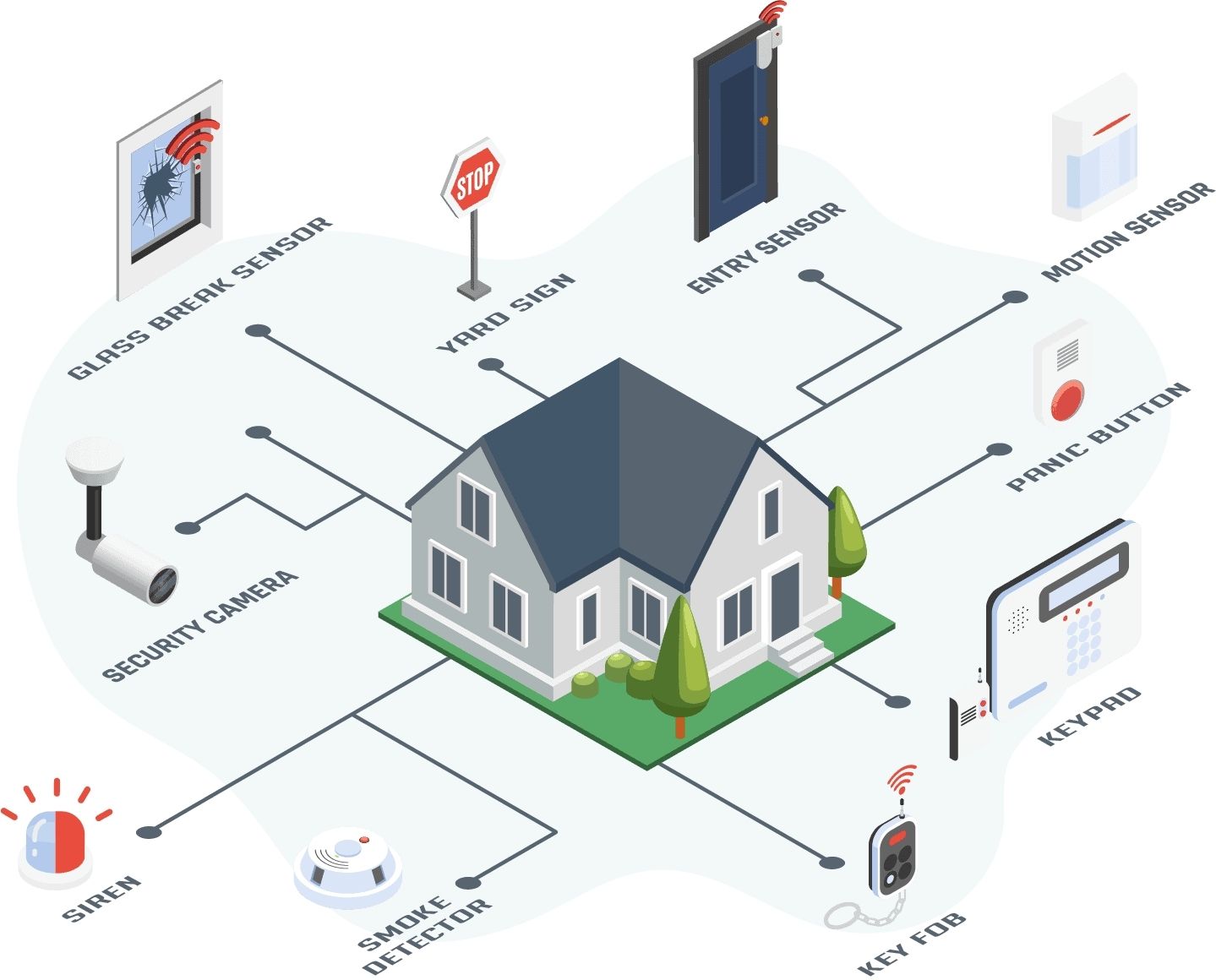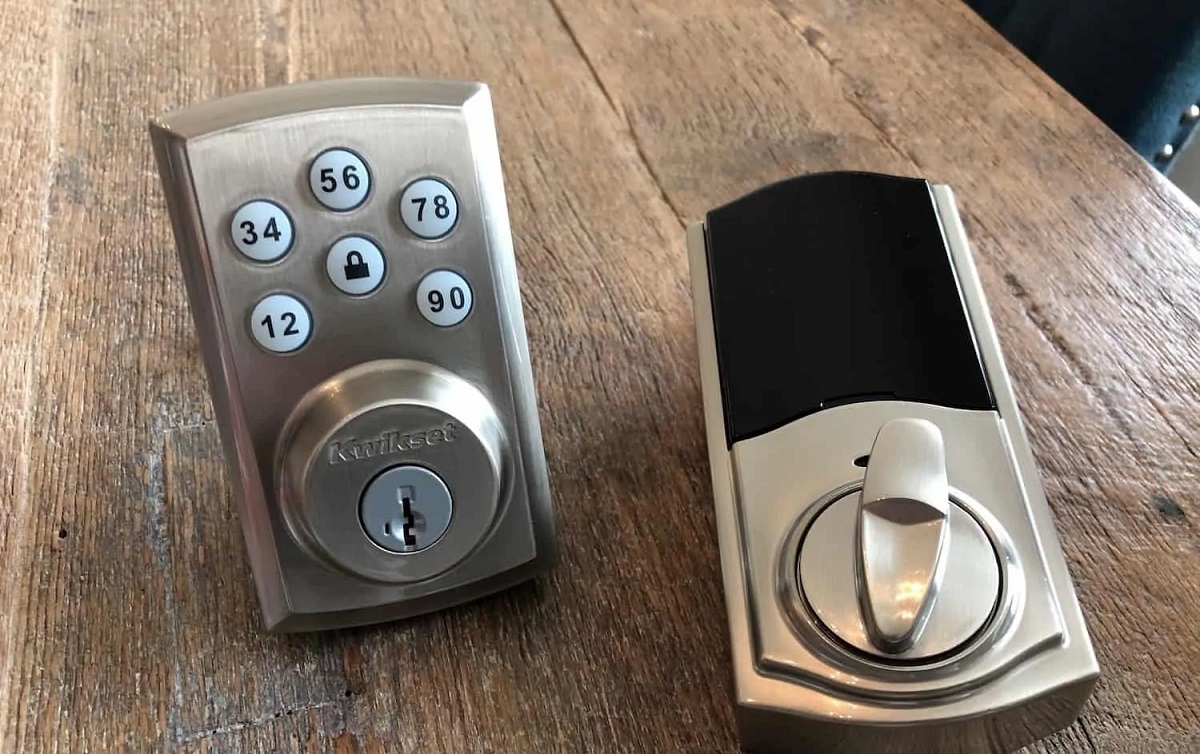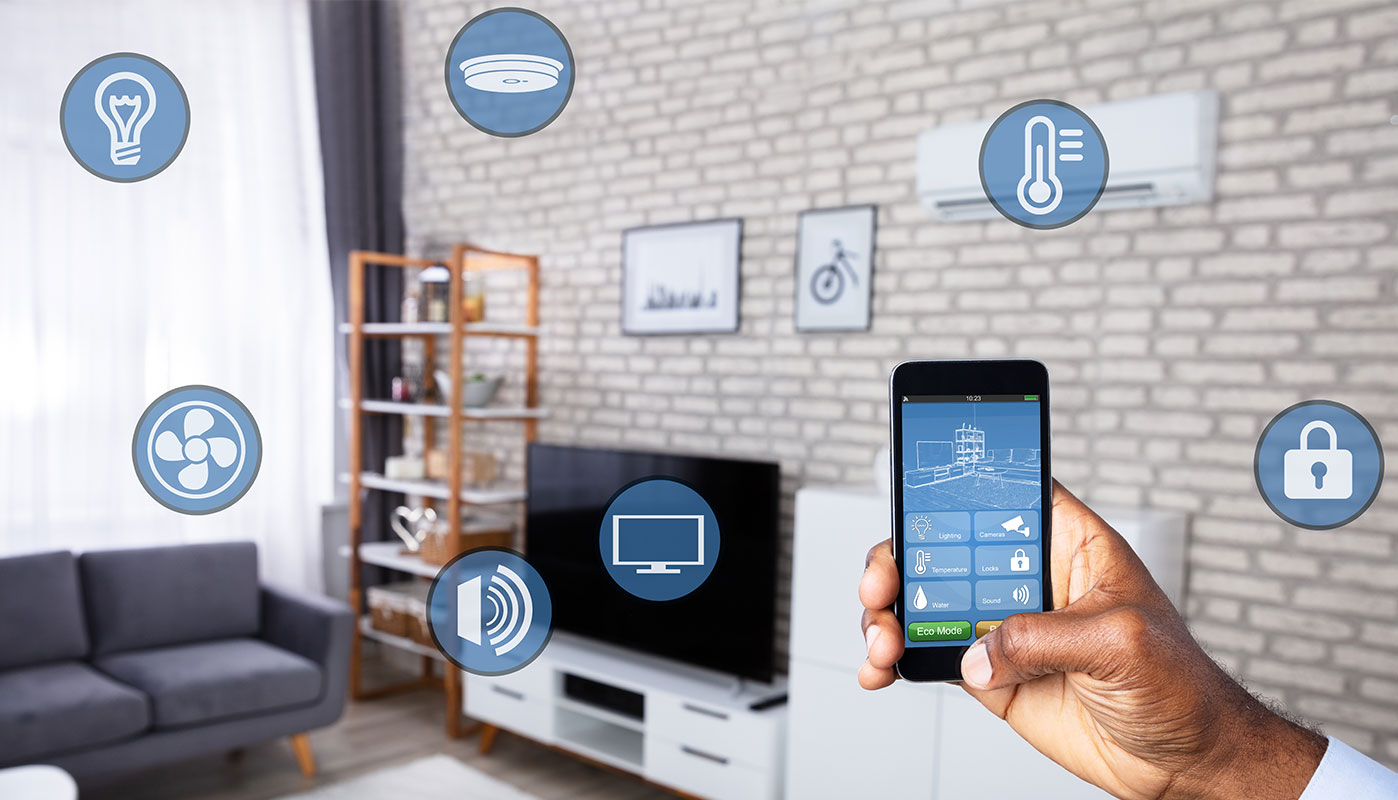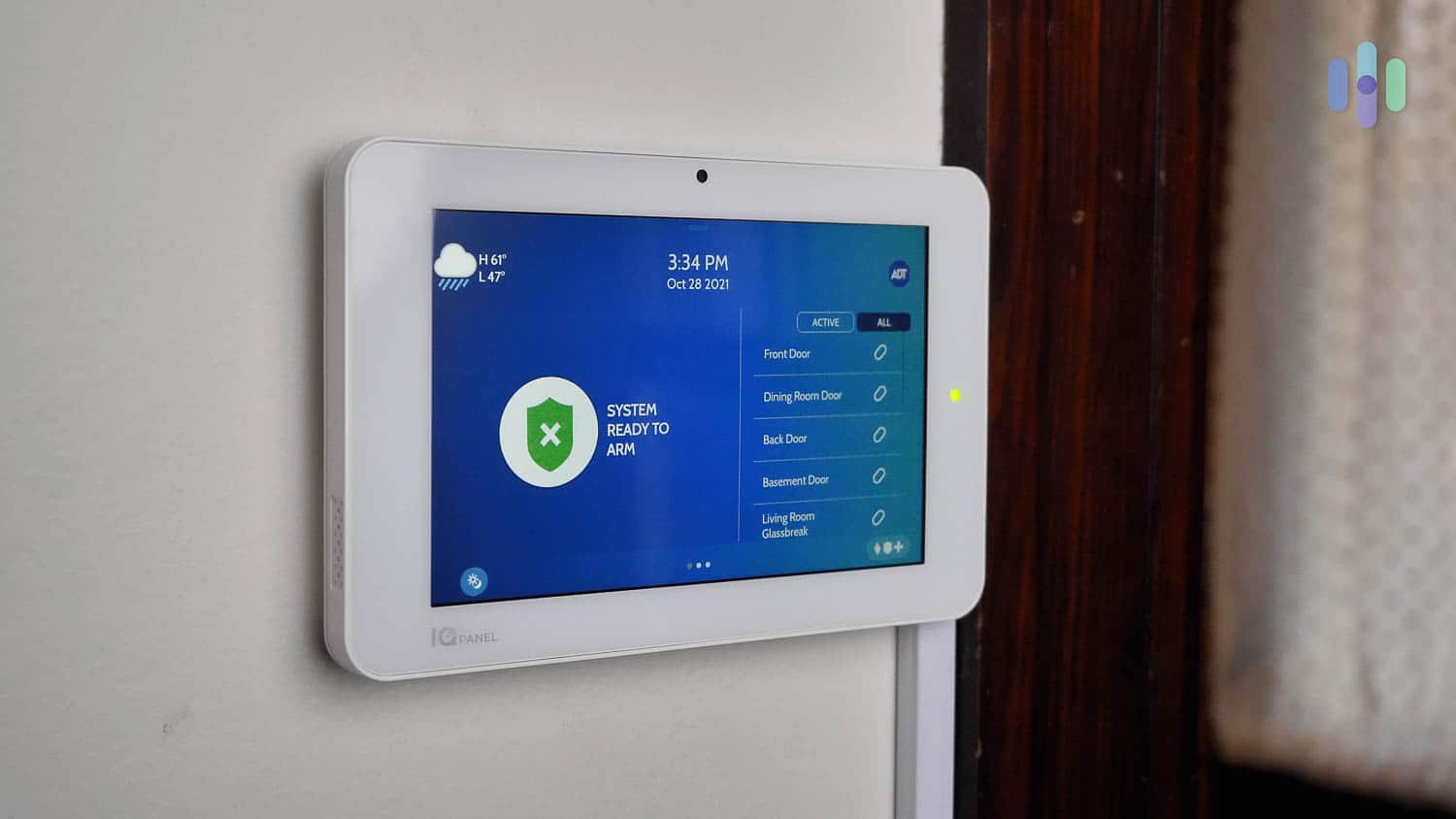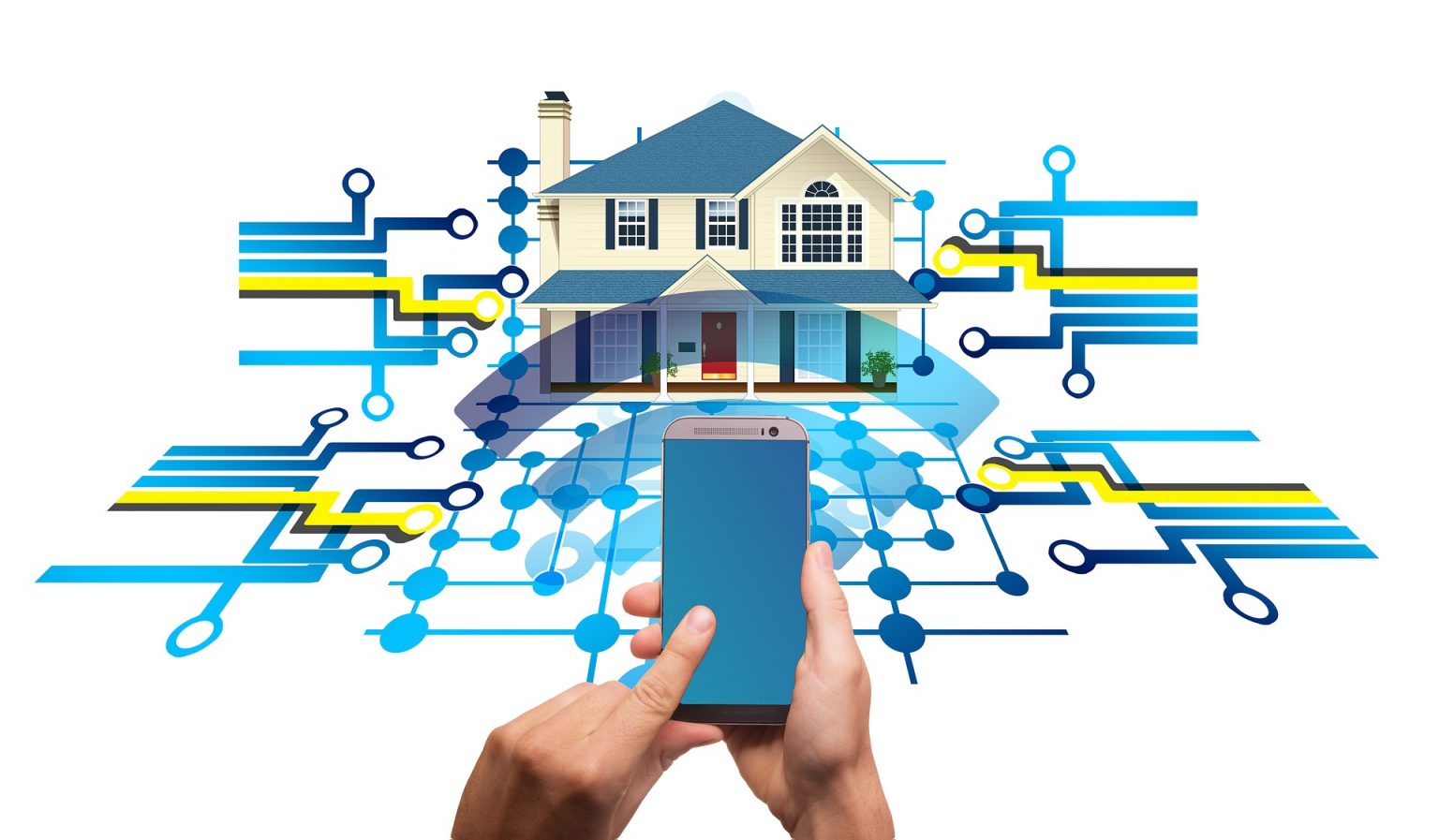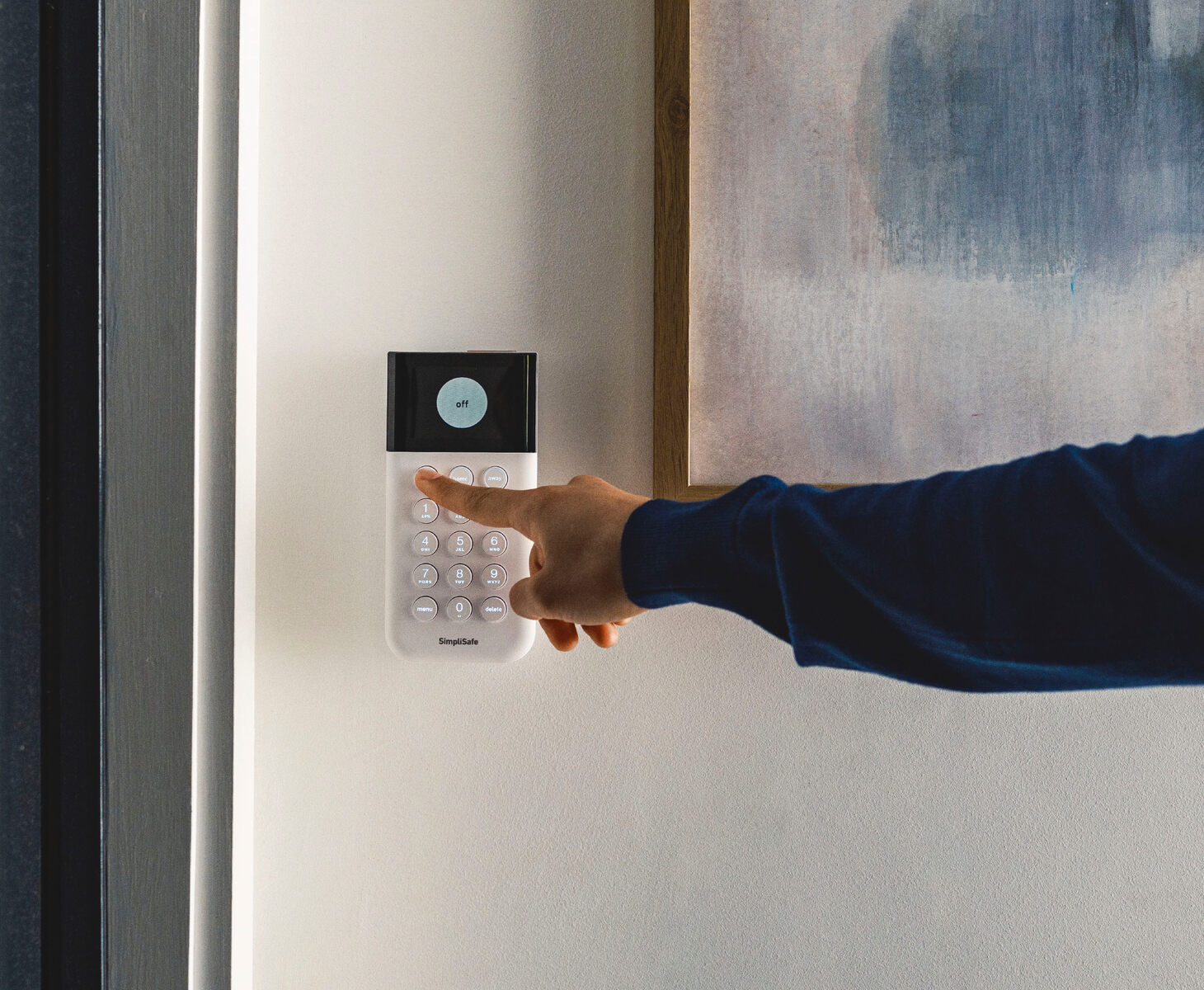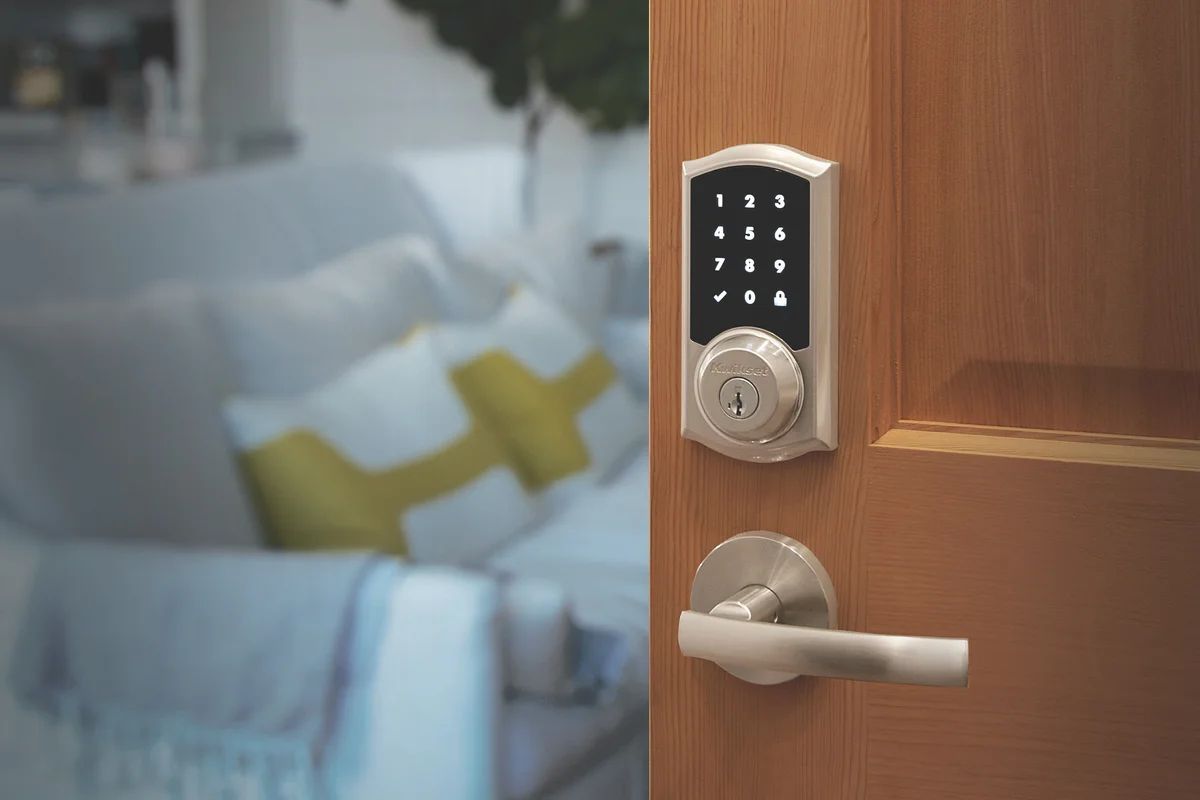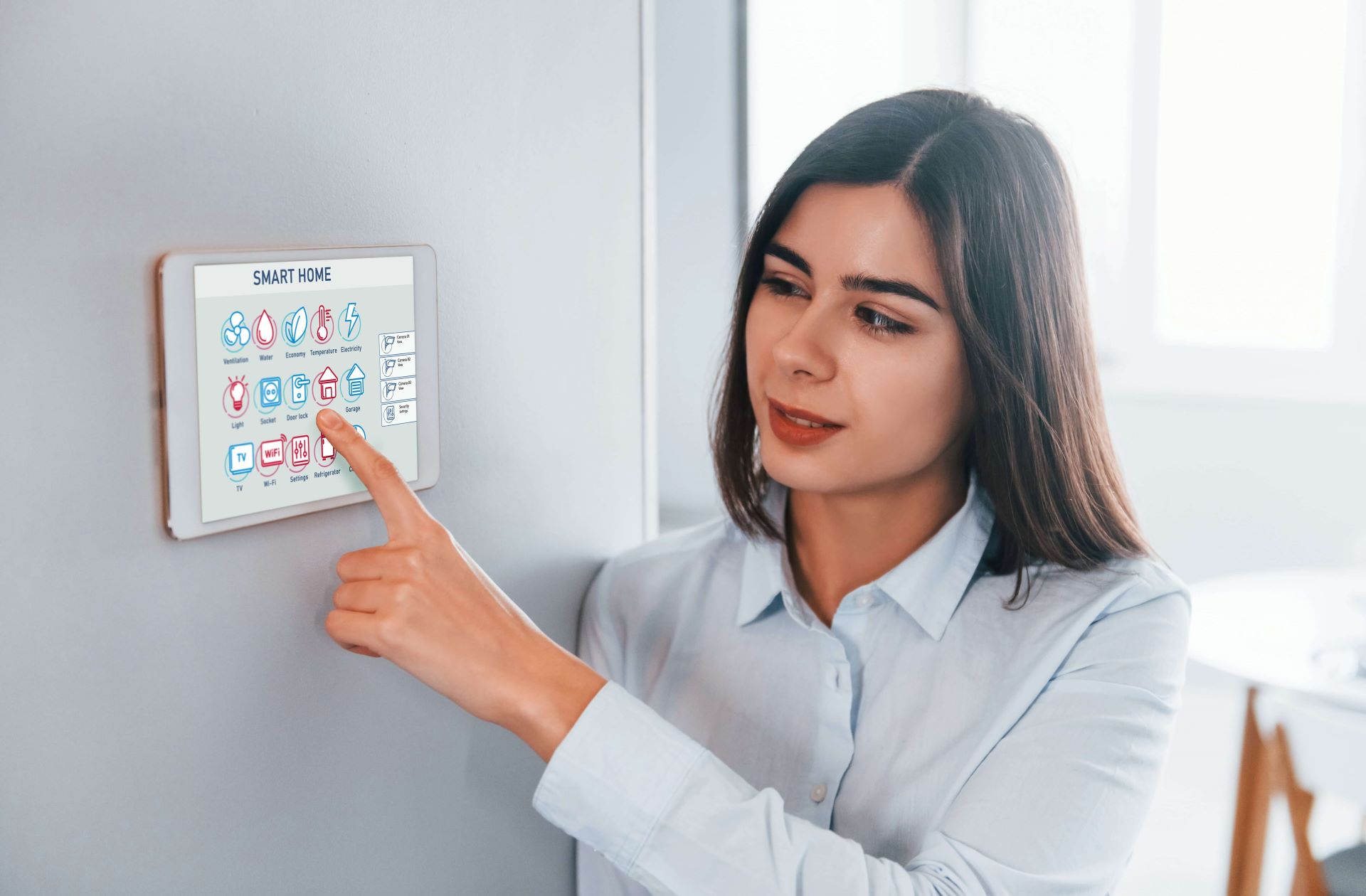What is a Smart Home Security System?
A smart home security system is a cutting-edge technology that combines traditional home security measures with advanced automation features. It allows homeowners to remotely monitor and control their home’s security from anywhere using their smartphones or other internet-connected devices. This innovative system uses a network of interconnected devices and sensors to provide enhanced protection against potential threats such as burglaries, fire, and even environmental hazards.
Unlike traditional security systems that rely on landline connections or manual operation, smart home security systems utilize wireless communication protocols like Wi-Fi, Bluetooth, or Z-Wave. This enables seamless integration with other smart devices in your home, such as smart locks, cameras, motion sensors, and door/window sensors, creating a comprehensive security ecosystem.
With a smart home security system, you can receive real-time alerts and notifications on your smartphone whenever a security event occurs, allowing you to take immediate action. Whether you’re at work, on vacation, or just running errands, you can have peace of mind knowing that your home is constantly monitored and protected.
Furthermore, smart home security systems offer advanced features like video monitoring, two-way audio communication, and even the ability to remotely control lights, thermostats, and other appliances. This not only provides convenience but also allows you to create the illusion of activity at home, deterring potential intruders.
Overall, a smart home security system offers homeowners a comprehensive and convenient way to safeguard their properties and ensure the safety of their loved ones. With its advanced technology and versatile features, it has become an essential component of modern home security.
How does a Smart Home Security System work?
A smart home security system works by utilizing a network of interconnected devices and sensors to monitor your home and detect potential security threats. These devices communicate with a central hub or control panel, which then relays the information to your smartphone or other internet-connected devices. Here is a breakdown of how a smart home security system works:
1. Sensors: Smart home security systems use various sensors to detect activities and events. These include door/window sensors, motion sensors, glass break sensors, and smoke/CO detectors. These sensors are strategically placed around your home to provide comprehensive coverage.
2. Hub or Control Panel: The hub or control panel acts as the brain of the security system. It receives signals from the sensors and communicates with your smartphone or other devices through Wi-Fi or cellular connections. It also allows you to arm or disarm the system and configure settings.
3. Smartphone or Device Integration: Once the hub receives a signal from a sensor, it sends a notification or alert to your smartphone or device. This allows you to stay informed about security events in real-time, no matter where you are.
4. Monitoring Services: Many smart home security systems offer professional monitoring services. In the event of a security breach, the system will alert the monitoring center, which can then dispatch emergency responders if necessary. This provides an additional layer of protection, especially when you’re unable to respond to alerts.
5. Automation and Integration: One of the key features of a smart home security system is automation. It allows you to integrate other smart devices, such as smart locks, cameras, and lights, into the system. For example, you can set up a rule that automatically turns on the lights when motion is detected or locks the doors when you arm the security system.
By combining advanced technology, sensors, and connectivity, a smart home security system creates a seamless and intelligent security ecosystem. It offers not only real-time monitoring and alerts but also the ability to control and automate various aspects of your home’s security.
Key components of a Smart Home Security System
A smart home security system consists of several essential components that work together to provide comprehensive protection for your home. Each component plays a specific role in ensuring the security and safety of your property. Here are the key components of a smart home security system:
1. Control Panel or Hub: The control panel or hub is the central command center of the security system. It communicates with all the connected devices, receives signals from sensors, and allows you to control and monitor the system through a user-friendly interface. This can be a dedicated control panel or an app on your smartphone.
2. Sensors: Sensors are vital components of a smart home security system. These include door/window sensors, motion sensors, glass break sensors, and smoke/CO detectors. They detect any unusual activity or changes in the environment and send alerts to the control panel, triggering appropriate actions or notifications.
3. Cameras: Surveillance cameras are essential for monitoring and recording activities in and around your home. They provide real-time video footage that can be accessed remotely through your smartphone or other devices. Some cameras also offer advanced features like facial recognition and night vision for enhanced security.
4. Smart Locks: Smart locks allow you to lock and unlock your doors remotely, without the need for physical keys. They can be integrated into the security system and controlled through the same app or control panel. Smart locks provide convenience and added security by enabling you to grant access to visitors or service providers remotely.
5. Alarms and Sirens: Alarms and sirens are effective deterrents that alert you and your neighbors in case of a security breach. When triggered by sensors or manually through the app, they emit loud sounds to scare off intruders and draw attention to the situation. Some systems also offer silent alarms that directly notify the authorities or a monitoring center.
6. Smart Lighting: Smart lighting can be integrated into the security system to enhance security and create the illusion of activity in your home. You can schedule lights to turn on and off at specific times or control them remotely, making it look like someone is home even when you’re away. This helps deter potential burglars.
7. Monitoring Services: Some smart home security systems offer professional monitoring services. These services provide 24/7 monitoring and can dispatch emergency responders if a security breach is detected. This adds an extra layer of protection, especially when you are unable to respond to alerts.
By combining these key components, a smart home security system offers enhanced protection, convenience, and peace of mind. It allows you to monitor and control your home’s security from anywhere, ensuring the safety of your property and loved ones.
Benefits of a Smart Home Security System
A smart home security system offers a range of benefits that go beyond traditional security measures. Here are some of the key advantages of installing a smart home security system:
Enhanced Protection: With a smart home security system, you have a comprehensive and advanced security solution in place. The combination of sensors, cameras, and alarms provides increased protection against burglaries, break-ins, and other threats. You can monitor your property in real-time and receive instant alerts on your smartphone whenever a security event occurs.
Remote Monitoring and Control: One of the major benefits of a smart home security system is the ability to monitor and control your home’s security remotely. With an app on your smartphone or other internet-connected devices, you can arm or disarm the system, view live camera feeds, lock or unlock doors, and even adjust lighting and thermostats from anywhere. This level of control gives you peace of mind, especially when you’re away from home.
Deterrence: Smart home security systems come with features like motion-activated lights, sirens, and even the ability to play recorded sounds to deter potential intruders. The presence of visible security measures, combined with the ability to remotely control lights and simulate occupancy, creates the impression that someone is always home, reducing the likelihood of break-ins.
Real-Time Alerts: By receiving real-time alerts and notifications on your smartphone, you can stay informed about any security events happening at your home. Whether it’s a door being opened, motion detected in a restricted area, or a smoke alarm going off, you’ll be promptly notified. This allows you to take immediate action, whether it’s contacting the authorities or checking the live camera feed to assess the situation.
Integration with Other Smart Devices: A smart home security system can be integrated with other smart devices in your home, such as smart locks, cameras, and lighting systems. This creates a cohesive ecosystem where all these devices work together to enhance security and convenience. For example, you can automatically lock the doors and turn off lights when you arm the security system, or receive security camera feeds on your TV screen.
Insurance Benefits: Many insurance companies offer discounts on homeowner’s insurance premiums for properties equipped with a smart home security system. By demonstrating that you have taken proactive steps to secure your home, you can qualify for lower insurance rates, resulting in long-term cost savings.
Peace of Mind: Perhaps the most significant benefit of a smart home security system is the peace of mind it provides. Whether you’re at work, on vacation, or just out running errands, you can have confidence in knowing that your home is protected. The ability to monitor and control your home’s security remotely gives you a sense of control and reassurance.
In summary, a smart home security system offers enhanced protection, convenience, and peace of mind. It allows you to monitor and control your home’s security remotely, receive real-time alerts, and integrate with other smart devices. With these benefits, investing in a smart home security system is a worthwhile decision for any homeowner.
Popular Features of Smart Home Security Systems
Smart home security systems are equipped with various features that enhance the overall security and convenience of your home. These features are designed to provide comprehensive protection and ease of use. Here are some popular features found in smart home security systems:
1. Real-Time Video Monitoring: Smart home security systems often include surveillance cameras that provide real-time video monitoring. You can access the camera feeds remotely through your smartphone or other devices, allowing you to keep an eye on your property at all times. Some systems even offer two-way audio communication, enabling you to speak to visitors or potential intruders.
2. Motion Detection: Many smart home security systems incorporate motion sensors that can detect movement in and around your home. These sensors trigger alerts and notifications to your smartphone whenever motion is detected, keeping you informed of any suspicious activity. Motion detection is especially useful for outdoor security or areas with valuable assets.
3. Door and Window Sensors: Door and window sensors are an integral part of a smart home security system. These sensors can detect if a door or window is opened or breached, triggering an alert on your smartphone. This feature provides an extra layer of security, alerting you to potential break-ins and allowing you to take immediate action.
4. Smart Lock Integration: Smart home security systems often integrate with smart locks, providing convenient and secure access to your home. You can remotely lock or unlock your doors, grant temporary access to visitors, and receive alerts when someone enters or exits your home. This feature gives you control over who has access to your property.
5. Environmental Monitoring: Some smart home security systems include environmental sensors to monitor for potential hazards like smoke, fire, or carbon monoxide. These sensors can detect changes in temperature and air quality, sending alerts to your smartphone if any dangerous conditions are detected. This early detection can help prevent major disasters.
6. Smart Home Integration: Smart home security systems are designed to integrate with other smart devices in your home, creating a cohesive and interconnected ecosystem. You can link your security system with devices like smart lights, thermostats, and voice assistants. This integration allows you to customize automation routines, such as turning on lights or adjusting the temperature when you arm the security system.
7. Mobile App Control: Most smart home security systems come with a mobile app that allows you to control and monitor your system from anywhere. With the app, you can arm or disarm the system, receive alerts, view camera feeds, and manage system settings. This remote accessibility and control make it easier to manage your home’s security even when you’re away.
8. Professional Monitoring: Some smart home security systems offer professional monitoring services. This means that if an alarm is triggered, a monitoring center will be notified, and they can dispatch emergency services if needed. Professional monitoring provides an additional layer of security and peace of mind, especially when you are unable to respond to alerts yourself.
Incorporating these popular features, smart home security systems provide enhanced security, convenience, and peace of mind. Whether it’s real-time video monitoring, motion detection, or integration with other smart devices, these features work together to create a comprehensive and efficient home security solution.
Choosing the Right Smart Home Security System for You
Choosing the right smart home security system for your needs requires careful consideration of several factors. With the array of options available in the market, it’s important to find a system that suits your specific requirements and preferences. Here are some key factors to consider when selecting a smart home security system:
1. Budget: Determine your budget for a smart home security system. Prices can vary depending on the features, number of devices, and monitoring services. Consider the upfront costs, ongoing fees, and any additional accessories you may need to purchase.
2. Home Size and Coverage: Assess the size of your home and the areas that need security coverage. This will help you determine the number of sensors, cameras, and other devices required to adequately secure your property.
3. System Scalability: Consider how easily the system can be expanded or customized in the future. If you plan on adding more devices or expanding your security coverage, ensure that the system can accommodate these changes without major issues.
4. Monitoring Options: Decide whether you prefer self-monitoring or professional monitoring services. Self-monitoring allows you to monitor the system yourself and respond to alerts, while professional monitoring involves a monthly fee and offers 24/7 monitoring and response from a monitoring center.
5. Mobile App and Remote Access: Check the features and usability of the mobile app provided by the security system. Ensure that it is user-friendly and offers the functionality you need, such as remote access, notifications, and control of the system from your smartphone or other devices.
6. Integration with Other Smart Devices: If you already have other smart devices in your home, such as smart locks, lights, or a voice assistant, consider how well the security system integrates with these existing devices. Compatibility and seamless integration can enhance the overall convenience and automation capabilities of your smart home.
7. Customer Support and Reputation: Research the reputation and customer support of the security system provider. Look for reviews, ratings, and feedback from other users to gauge their reliability, response times, and overall customer satisfaction.
8. Additional Features: Consider any additional features that are important to you, such as two-way audio communication, facial recognition, or environmental monitoring. Assess whether these features align with your security needs and preferences.
By carefully evaluating these factors, you can find the right smart home security system that meets your specific requirements. Take your time to research different options, compare features and prices, and read customer reviews to make an informed decision. Investing in the right system will provide you with peace of mind and enhanced security for your home.
Installation and Setup of a Smart Home Security System
Installing and setting up a smart home security system may vary depending on the specific system you choose, but here are some general steps to guide you through the process:
1. Planning: Before installation, carefully plan where you want to place sensors, cameras, and other devices. Consider the layout of your home, entry points, and areas that require coverage. Take note of power outlets and Wi-Fi signal strength for optimal device placement.
2. Device Placement: Install door/window sensors on each entry point of your home, ensuring they have a secure fit. Position motion sensors in strategic locations, covering high-traffic areas. Cameras should be strategically placed to capture key areas and provide maximum coverage.
3. Hub or Control Panel Setup: If your system utilizes a hub or control panel, follow the manufacturer’s instructions to connect and set it up. This may involve plugging it into a power outlet and connecting it to your home Wi-Fi network.
4. Sensor Pairing: Pair each sensor with the control panel or hub according to the instructions provided. This is typically done by initiating the pairing mode on the sensor and then following the instructions on the control panel or app to connect them.
5. Camera Setup: If your system includes cameras, follow the manufacturer’s instructions to install and position them. This may involve mounting them on walls or ceilings and connecting them to power sources and the control panel or hub.
6. App Installation and Configuration: Install the mobile app associated with your smart home security system on your smartphone or other devices. Follow the setup process provided by the app to connect it to your system and configure settings as needed.
7. Testing: Once the installation and setup are complete, perform thorough testing to ensure all devices are properly connected and functioning. Test sensors, cameras, alarms, and other components to verify their responsiveness and accuracy.
8. Customization and Integration: Take advantage of the customization options available within the system. Set up automation rules, configure notifications, and integrate the security system with other smart devices you may have in your home.
9. Professional Assistance: If you are unsure or uncomfortable with the installation process, consider seeking professional assistance. Many smart home security system providers offer professional installation services for a fee.
Remember to carefully read and follow the manufacturer’s instructions and guidelines provided with your specific system. If you encounter any difficulties or have questions during the installation process, reach out to customer support for assistance. Proper installation and setup ensure that your smart home security system functions optimally, providing the desired levels of security and peace of mind.
Smart Home Security System vs Traditional Security Systems
Smart home security systems offer several advantages over traditional security systems, making them a popular choice for homeowners. Here are some key differences between smart home security systems and traditional security systems:
1. Connectivity and Control: Smart home security systems are connected via Wi-Fi or other wireless communication protocols, allowing you to monitor and control your system remotely. Traditional security systems typically rely on landline connections or manual operation, limiting their accessibility and control options.
2. Automation and Integration: Smart home security systems offer automation and integration capabilities, allowing seamless integration with other smart devices in your home. You can automate actions like turning on lights when motion is detected or locking doors when the system is armed. Traditional security systems lack these automation and integration features.
3. Remote Monitoring and Alerts: With a smart home security system, you can receive real-time alerts and notifications on your smartphone whenever a security event occurs. You can monitor your home even when you’re away. In contrast, traditional security systems generally rely on local alarms or require third-party monitoring services for remote alerts and monitoring.
4. User-Friendly Interfaces: Smart home security systems often come with user-friendly interfaces, such as mobile apps, that make it easy to monitor and control your security system. Traditional security systems often have complex control panels and may require professional assistance for programming and operation.
5. Scalability and Flexibility: Smart home security systems are scalable, allowing you to easily expand and customize your system as needed. You can add additional sensors, cameras, and devices to cover more areas or enhance specific security features. Traditional security systems may require extensive rewiring or configuration to accommodate changes.
6. Cost-effectiveness: While smart home security systems may have higher upfront costs, they can offer long-term cost savings. They eliminate the need for professional installation and offer flexible monitoring options, allowing you to choose self-monitoring or professional monitoring services as per your budget and preferences. Traditional security systems often require professional installation and ongoing monthly fees for monitoring services.
7. Enhanced Security Features: Smart home security systems often offer advanced security features like real-time video monitoring, two-way audio communication, and facial recognition. These features provide additional layers of security and help prevent false alarms. Traditional security systems typically have basic alarm systems without these advanced features.
8. Integration with Other Systems: Smart home security systems can integrate with other smart devices, such as smart lights and locks, to create a comprehensive smart home ecosystem. This integration enhances convenience and allows for more efficient control of your home’s security. Traditional security systems are typically standalone and have limited integration capabilities.
In summary, smart home security systems offer superior connectivity, automation, control, and scalability compared to traditional security systems. They provide more advanced features, increased accessibility, and flexibility for homeowners, making them a preferred choice for modern home security.
How to Maximize the Effectiveness of Your Smart Home Security System
A smart home security system can provide optimal protection for your home and loved ones when utilized effectively. By following these tips, you can maximize the effectiveness of your smart home security system:
1. Choose the right components: Ensure that you have selected the appropriate sensors, cameras, and devices based on the layout and size of your home. The right components will provide adequate coverage and protection for your specific needs.
2. Proper device placement: Place sensors, cameras, and motion detectors strategically throughout your home. Consider high-risk areas such as entry points and windows. Optimal device placement ensures that you will be alerted promptly and have visual evidence of any potential security events.
3. Regularly update and maintain the system: Keep your smart home security system up to date with the latest firmware and software updates. Regularly check batteries and replace them as needed. Proper maintenance ensures that your system operates optimally and reduces the risk of malfunctions.
4. Enable notifications and alerts: Take advantage of the notification and alert features provided by your smart home security system. Ensure that you have enabled push notifications and set up alerts for specific events, such as a door being opened or motion detected. This allows you to stay informed in real-time.
5. Utilize automation features: Leverage the automation capabilities of your smart home security system. Set up routines that automatically arm the system when you leave home or adjust lights and thermostats to simulate occupancy. Automation enhances security and creates the illusion of an occupied home even when you’re away.
6. Integrate with other smart devices: Connect your smart home security system with other devices in your home, such as smart locks, lights, and voice assistants. This integration allows for seamless control and coordination, enhancing the overall effectiveness of your security system.
7. Secure your network and devices: Ensure that your home network is secure by using strong passwords and encryption protocols. Regularly update your Wi-Fi password and use two-factor authentication when available. Additionally, protect your connected devices by keeping them updated and using unique passwords.
8. Familiarize yourself with the system’s features: Take the time to understand and explore the features and capabilities of your smart home security system. Learn how to navigate the control panel or app effectively, configure settings, and customize preferences. This knowledge will empower you to use the system to its fullest potential.
9. Regularly test and conduct maintenance: Periodically test your smart home security system to ensure that all devices are functioning correctly. Test sensors, cameras, and alarms to verify their responsiveness. Conduct routine maintenance, such as cleaning camera lenses, to maintain optimal performance.
By implementing these strategies, you can maximize the effectiveness of your smart home security system. Take full advantage of its capabilities, keep it well-maintained, and integrate it with other devices for enhanced security and peace of mind.
Conclusion
A smart home security system provides a modern and comprehensive solution to protect your home and loved ones. With its advanced features, remote monitoring capabilities, and integration with other smart devices, it offers convenience and peace of mind. Through the use of sensors, cameras, and automation, a smart home security system enhances your home’s security by providing real-time alerts, deterring potential intruders, and allowing remote control from anywhere.
By choosing the right components, properly installing and setting up the system, and maximizing its features, you can optimize the effectiveness of your smart home security system. This includes strategic device placement, regular updates and maintenance, enabling notifications and alerts, utilizing automation features, and integrating the system with other smart devices.
However, it’s essential to remember that a smart home security system should serve as a valuable addition to other security measures, such as robust locks, proper lighting, and neighborhood awareness. It is also crucial to follow best practices for network and device security to ensure the overall integrity of your system.
In conclusion, investing in a smart home security system can provide you with enhanced security, convenience, and peace of mind. The ability to monitor and control your home’s security remotely, receive real-time alerts, and integrate with other smart devices makes it a worthwhile investment. By understanding the system’s features, properly maintaining it, and following recommended practices, you can maximize the effectiveness of your smart home security system and create a safer and more secure living environment for you and your family.







